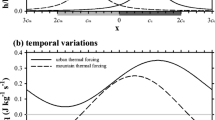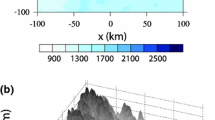Abstract
The two-dimensional interactions of urban breeze circulation with mountain slope winds are investigated using the Weather Research and Forecasting (WRF) model coupled with the Seoul National University Urban Canopy Model (SNUUCM). A city is located near an isolated mountain, and there is no basic-state wind. Circulation over the urban area is asymmetric and characterized by the weakened mountain-side urban wind due to the opposing upslope wind and the strengthened plain-side urban wind in the daytime. The transition from upslope wind to downslope wind on the urban-side mountain slope occurs earlier than that on the mountain slope in a simulation that includes only an isolated mountain. A hydraulic jump occurs in the late afternoon, when the strong downslope wind merges with weaker mountain-side urban wind and stagnates until late evening. The sensitivities of the interactions of urban breeze circulation with mountain slope winds and urban heat island intensity to mountain height and urban fraction are also examined. As mountain height decreases and urban fraction increases, the transition from urban-side upslope wind to downslope wind occurs earlier and the urban-side downslope wind persists longer. This change in transition time from urban-side upslope wind to downslope wind affects the interactions between urban breeze circulation and mountain slope winds. Urban heat island intensity is more sensitive to urban fraction than to mountain height. Each urban fraction increase of 0.1 results in an average increase of 0.17 °C (1.27 °C) in the daytime (nighttime) urban heat island intensity. A simulation in which a city is located in a basin shows that the urban-side downslope wind develops earlier, persists longer, and is stronger than in the simulation that includes a city and an isolated mountain.










Similar content being viewed by others
References
Chen F, Dudhia J (2001) Coupling an advanced land surface–hydrology model with the Penn State–NCAR MM5 modeling system. Part I: model implementation and sensitivity. Mon Weather Rev 129:569–585
Chen SH, Sun WY (2002) A one-dimensional time dependent cloud model. J Meteorol Soc Jpn 80:99–118
de Wekker SFJ, Zhong S, Fast JD, Whiteman CD (1998) A numerical study of the thermally driven plain-to-basin wind over idealized basin topographies. J Appl Meteorol 37:606–622
Dudhia J (1989) Numerical study of convection observed during the winter monsoon experiment using a mesoscale two-dimensional model. J Atmos Sci 46:3077–3107
Fernando HJS (2010) Fluid dynamics of urban atmospheres in complex terrain. Annu Rev Fluid Mech 42:365–389
Hidalgo J, Masson V, Pigeon G (2008a) Urban-breeze circulation during the CAPITOUL experiment: numerical simulations. Meteorol Atmos Phys 102:243–262
Hidalgo J, Pigeon G, Masson V (2008b) Urban-breeze circulation during the CAPITOUL experiment: observational data analysis approach. Meteorol Atmos Phys 102:223–241
Hong SY, Noh Y, Dudhia J (2006) A new vertical diffusion package with an explicit treatment of entrainment processes. Mon Weather Rev 134:2318–2341
Kimura F, Kuwagata T (1993) Thermally induced wind passing from plain to basin over a mountain range. J Appl Meteorol 32:1538–1547
Kimura F, Kuwagata T (1995) Horizontal heat fluxes over complex terrain computed using a simple mixed-layer model and a numerical model. J Appl Meteorol 34:549–558
Lee SH, Kim HD (2010) Modification of nocturnal drainage flow due to urban surface heat flux. Asia-Pac J Atmos Sci 46:453–465
Lee SH, Kimura F (2001) Comparative studies in the local circulations induced by land-use and by topography. Bound-Layer Meteorol 101:157–182
Lemonsu A, Masson V (2002) Simulation of a summer urban-breeze over Paris. Bound-Layer Meteorol 104:463–490
Mlawer EJ, Taubman SJ, Brown PD, Iacono MJ, Clough SA (1997) Radiative transfer for inhomogeneous atmospheres: RRTM, a validated correlated-k model for the longwave. J Geophys Res 102:16663–16682
Ohashi Y, Kida H (2002) Effects of mountains and urban areas on daytime local-circulations in the Osaka and Kyoto regions. J Meteorol Soc Jpn 80:539–560
Pielke RA (2002) Mesoscale meteorological modeling, 2nd edn. Academic Press, San Diego
Ryu YH, Baik JJ (2013) Daytime local circulations and their interactions in the Seoul metropolitan area. J Appl Meteorol Climatol 52:784–801
Ryu YH, Baik JJ, Lee SH (2011) A new single-layer urban canopy model for use in mesoscale atmospheric models. J Appl Meteorol Climatol 50:1773–1794
Ryu YH, Baik JJ, Han JY (2013a) Daytime urban breeze circulation and its interaction with convective cells. Q J R Meteorol Soc 139:401–413
Ryu YH, Baik JJ, Kwak KH, Kim S, Moon N (2013b) Impacts of urban land-surface forcing on ozone air quality in the Seoul metropolitan area. Atmos Chem Phys 13:2177–2194
Savijarvi H, Liya J (2001) Local winds in a valley city. Bound-Layer Meteorol 100:301–319
Simpson JE (1994) Sea breeze and local winds. Cambridge University Press, New York
Skamarock WC, Klemp JB, Dudhia J, Gill DO, Barker DM, Duda MG, Huang XY, Wang W, Powers JG (2008) A description of the advanced research WRF version 3. NCAR, Boulder
Wong KK, Dirks RA (1978) Mesoscale perturbations on airflow in the urban mixing layer. J Appl Meteorol 17:677–688
Zhang N, Wang X, Peng Z (2014) Large-eddy simulation of mesoscale circulations forced in inhomogeneous urban heat island. Bound-Layer Meteorol 151:179–194
Acknowledgments
The authors are grateful to two anonymous reviewers and Jaemyeong Mango Seo for providing valuable comments on this work. This work was funded by the National Research Foundation of Korea (NRF) grant funded by the Korea Ministry of Education, Science and Technology (MEST) (No. 2012-0005674).
Author information
Authors and Affiliations
Corresponding author
Rights and permissions
About this article
Cite this article
Ganbat, G., Baik, JJ. & Ryu, YH. A numerical study of the interactions of urban breeze circulation with mountain slope winds. Theor Appl Climatol 120, 123–135 (2015). https://doi.org/10.1007/s00704-014-1162-7
Received:
Accepted:
Published:
Issue Date:
DOI: https://doi.org/10.1007/s00704-014-1162-7




